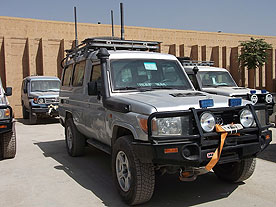Improvised Explosive Devices, the war of the invisible bombs
More than half the casualties among the NATO forces in Afghanistan in 2011 were caused by improvised explosive devices (IED)¹. This is also the case for one in three Afghans killed last year². In 2010, NATO adopted an action plan on counter-IED(C-IED) aimed at increasing the detection and neutralization of such devices, as well as the dismantling of the networks that manufacture them. The NATO C3 Agency (NC3A) is responsible for developing those advanced technologies to combat IEDs.

The NC3A has concentrated its efforts in the struggle against IEDs in three main sectors – jammers against radio-controlled IEDs, scanners to inspect vehicles, cargo and pedestrians, and surveillance technologies to improve intelligence on the origins of the IEDs.
"It is difficult to fight these devices," explains Mr Franco Fiore, a C-IED specialist at the NC3A. "Detonation may be triggered by command, a time switch or a booby trap. They may be buried underground, or camouflaged to merge with the surroundings."
The imagination of insurgents is limitless. For minimal cost and half an hour of work, they can disguise IEDs to look like rocks, hide them in the bumpers of cars or conceal them in bottles of milk.

To protect ISAF forces during their mission in the field, and to maintain their mobility, jammers are fitted to vehicles to reduce the effectiveness of remotely-triggered devices. "The jammer deafens the IED receiver by shouting louder than the transmitter or talking over it," explains Mr Fiore.
"To start with, the difficulty of programming jammers was not to interfere with friendly communications," continues Mr Fiore.
The first scanner was installed in March 2007 at ISAF Headquarters in Kabul. "This technology allows us to scan and identify any explosive, weapon or contraband before the vehicle, the cargo or the pedestrian penetrates the compound. Each minute spent installing these scanners is worth the personnel investment and the effort. For what we accomplish on the ground makes the work of the protection forces safer and more secure," explains Mr Fiore. So far, more than 20 scanners have been installed in Afghanistan by Mr Fiore and his team.
In the field, the neutralization and disposal of IEDs falls primarily with the explosive ordnance disposal (EOD) teams. This is the most dangerous and exacting of tasks.
Their outstanding and exemplary work was illustrated in a recent film by Kathryn Bigelow, "The Hurt Locker", which won six Academy Awards, including Best Picture in 2010. This film gives a perfect picture of how EOD experts risk their lives on a daily basis. “With explosives you rarely get a second chance,” says Lt Cdr Ron Carpinella, the spokesman for Combined Joint Task Force (CJTF) Paladin, the task force responsible for C-IED operations in Afghanistan.
The greatest challenge rests with the localisation and identification of the threat. “By maintaining a high level of awareness and continuously updating our tactics and training, we can more effectively counter the IED threat, protect the innocent and step ahead of the insurgency,” continues Lt Cdr Carpinella. On the ground, trained bomb sniffer dogs remain the most effective way of detecting IEDs.
Attacking the sources of funding and financial circuits
Addressing the IED threat goes beyond the theatre of operations. Depriving those who manufacture IEDs of their main source of revenue is just as critical. Collection, analysis and dissemination of information among the different services concerned are key aspects of this.
“Effective analysis and dissemination of IED intelligence allows for the development and implementation of tactics to defeat the latest threats, identify the perpetrators of IED attacks and bring them to justice,” explains Lt Cdr Carpinella.
This also requires the involvement of financial specialists and money-laundering experts, increased focus and coordination among specialists from customs and intelligence services, and the development of targeted actions to identify IED manufacturers.
Examination of IEDs after they have been disarmed can also provide useful information. “Collecting, for example, fingerprints and safeguarding electronic and explosive components in a database are the basis for further investigations,” says Colonel Santiago San Antonio Demetrio, Director of the C-IED Centre of Excellence.
“Training in combating IEDs is principally focused on the ability to counter the networks before they put the devices in place,” adds Colonel San Antonio Demetrio.
C-IED training is also an integral part of pre-deployment training for troops. Once in theatre, their knowledge is brought up to date by ISAF personnel, in order to adapt to the specificities of the local area. In the future, non-EOD units will also receive similar training focusing on IED identification and what to do when confronted with them.
C-IED and Smart Defence
Smart Defence, through its multinational cooperation component, is in line with the NATO action plan for combating IEDs.
"Smart defence is to assist the nations in maintaining their military capabilities and develop new ones. By making economies of scale, you can save money and time and at the same time achieve better interoperability and standardization," concludes Mr Fiore.
In November 2011, 13 nations agreed to aim for serious cost savings by joint acquisition of technologies for combating IEDs. According to the NC3A, this concerted approach should allow the nations to save around 15 per cent.
